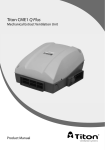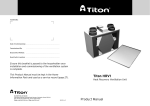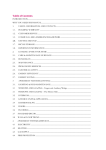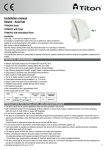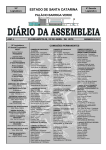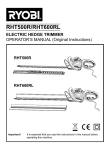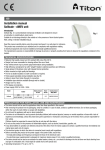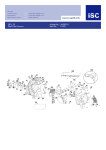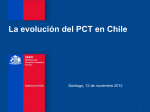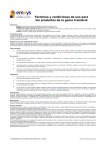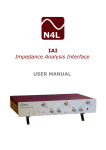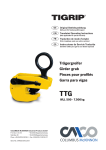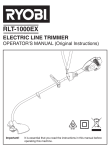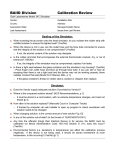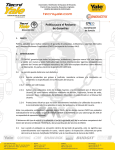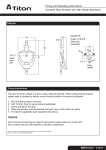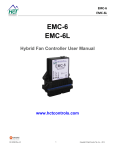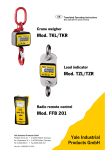Download CME1 Product Manual
Transcript
Titon CME1 Mechanical Extract Ventilation Unit Product Manual ventilation systems Online Version PCT Patent Application No PCT/GB2009/000114 2 Online Version Contents This is the Product Manual for the Titon CME1 (Not the CME1 Q Plus) Introduction . . . . . . . . . . . . . . . . . . . . . . . . . . . . . . . . . . . 4 Ventilation is Vital . . . . . . . . . . . . . . . . . . . . . . . . . . . . . . . . 5 How the System Works . . . . . . . . . . . . . . . . . . . . . . . . . . . . . . 6 How to Use the System. . . . . . . . . . . . . . . . . . . . . . . . . . . . . . 7 Product Features . . . . . . . . . . . . . . . . . . . . . . . . . . . . . . 7 Installation Safety and Guidance . . . . . . . . Transportation, Packaging & Storage . Inspection . . . . . . . . . . . . . Parts List . . . . . . . . . . . . . . Preparation . . . . . . . . . . . . . Dimensions . . . . . . . . . . . . . Component Identification . . . . . . Fixing . . . . . . . . . . . . . . . . Ducting Best Practice . . . . . . . . Ducting Connection . . . . . . . . . Wiring . . . . . . . . . . . . . . . Commissioning Speed Setting . . . . . . . . . . . . How to Change Speeds . . . . . . . . . . . . . . . . . . . . . . . . . . . . . . . . . . . . . . . . . . . . . . . . . . . . . . . . . . . . . . . . . . . . . . . . . . . . . . . . . . . . . . . . . . . . . . . . . . . . . . . . . . . . . . . . . . . . . . . . . . . . . . . . . . . . . . . . . . . . . . . . . . . . . . . . . . . . . . . . . . . . . . . . . . . . . . . . . . . . . . . . . . . . . . . . . . . . . . . . . . . . . . . . . . . . . . . . . 8 . 9 . 9 . 9 . 9 10 11 12 14 15 18 . . . . . . . . . . . . . . . . . . . 20 . . . . . . . . . . . . . . . . . . . 21 Maintenance Cleaning . . . . . . . . . . . . . . . . . . . . . . . . . . . . . . . . . 22 Declaration of Conformity . . . . . . . . . . . . . . . . . . . . . . . . . . . 25 Service Record . . . . . . . . . . . . . . . . . . . . . . . . . . . . . . . . . 26 Online Version 3 Introduction I nterior comfort, air quality and energy efficiency are vitally important considerations in buildings today. The Titon CME1 has been developed to meet these demands by extracting stale polluted air from the building whilst fresh air is provided by passive means. For the home owner or occupant, this Product Manual explains: • • • Why ventilation is vital for the good health of your home and its occupants. How your Titon CME1 system works. How to operate and maintain your Titon CME1. For the professional installer, this Product Manual explains: • • • How to install the Titon CME1. How to commission the unit. How to maintain the unit. It is important to read this Product Manual to ensure your ventilation system is installed, commissioned and used properly and continues to operate effectively. Failure to follow the guidance provided in this manual can have an adverse effect on health. 4 Online Version Ventilation is Vital C onstruction methods used in older homes resulted in uncontrolled ventilation via air leaking through the building structure, such as small gaps around windows and doors or between walls and floors. These leaks allowed a large amount of air to move through a home largely unnoticed by the occupants. Other factors, such as open fireplaces, people being at home more often and opening windows to “air” rooms during daytime, all helped maintain reasonable levels of air quality in homes. However, because this form of ventilation was uncontrolled, a large proportion of heat escaped to the outside and more energy was needed to make up for this loss. Modern homes have greatly reduced air leaks and indoor air quality can deteriorate rapidly without the use of products made to control ventilation Chemicals, gases and moisture produced by everyday products and activities may lead to the build up of excessive levels of pollutants which are harmful to the health of the occupants and may damage the building. Poor ventilation can be a major contributory factor of heart disease, lung disease, mental illness and many more threats to our health. Ventilation an essential ingredient The World Health Organisation and responsible Governments around the world recognise the vital importance of good indoor air quality. That is why building regulations govern the way homes are designed and built. Once homes are occupied it is the responsibility of the occupants to make sure they use and maintain the ventilation products following the guidance provided. Online Version 5 How the System Works T he Titon CME1 works by continually extracting stale polluted air from rooms where most moisture is generated. Fresh air is provided passively from outside to habitable rooms, creating a flow of fresh, clean air throughout the home. The air travels from terminals built into the ceiling which are connected by hidden ducts to the unit. The unit is usually installed in a roof space or cupboard. Each unit is commissioned individually so the amount of air moved is set to suit the specific size and style of the home. Most systems will also have a facility to boost the extraction rate at times when more moisture is being generated, such as when bathing or cooking. This may be done automatically by electronic sensors or by a conveniently located boost switch for manual operation. Exhaust CME1 Extract Terminals Typical system layout DO NOT switch off the unit; it is designed to run continuously. If the unit is switched off indoor pollutant and moisture levels may increase and become a danger to your health and damage your house. It is important to follow the advice in this user manual and correctly maintain the system to ensure a healthy indoor environment. 6 Online Version How to Use the System T he unit runs automatically and should not be switched off, except for maintenance. If a boost switch has been installed, it can be used to increase the extract ventilation rate at times when moisture or pollutant levels are considered excessive. You may have electronic sensors which detect high levels of moisture and pollutants which boost the system automatically. All ventilation units require periodic maintenance and this must only be carried out by a suitably qualified and competent person. See the servicing and maintenance section for further details. Product Features • • • • • • • Boost Control (normally via a two-way switch) Compact low profile unit Hidden installation fixings. All duct ports on one level Accepts 204mm x 60mm or 110mm x 54mm ducting. Unit can be cleaned and serviced without disturbing any ducting. Straightforward installation. Online Version 7 Installation Safety and Guidance • • • • • • The electrical installation of the appliance MUST be carried out by a suitably qualified competent person and all wiring must be in accordance with current I.E.E. Regulations and all appropriate standards and applicable regulatory guidance. The appliance must be connected to a local isolation switch with a contact separation of at least 3mm. The appliance is suitable for 230V ~ 50/60Hz single phase with a fuse rating of 3A. Ensure that external grills are located away from any flue outlet, in accordance with relevant Building Regulations. Always ensure ducting is free from blockages before switching the unit on. We recommend a minimum distance of 200mm between the appliance and any sharp bends in duct work. Installation of the appliance MUST be carried out by a qualified and suitably competent person and should be carried out in clean, dry conditions where dust and humidity are at minimal levels. The appliance is not suitable for installation to the exterior of the dwelling. For ducting recommendations see Ducting Best Practice, page13. Failure to comply with any of the above points will have an impact on the validity of your guarantee. 8 Online Version Installation Transportation, Packaging & Storage • • • Great care should be taken when transporting the appliance, DO NOT drop as damage may occur. The unit must always be stored in a clean and dry environment. Remove all packaging before installation but leaving duct port covers/bungs in place (if fitted) until connecting ducting. Inspection • • Inspect the appliance for damage. Check all accessories have been supplied. Parts List • • • CME1 Unit x 1. Port covers x 3. Product manual x 1. • CME1 Screw Pack x 1. All shortages or damage must be reported to the supplier. Preparation Important: read these instructions fully before the installation of this appliance • • NEVER install the CME1 in an area which does not have sufficient access the for future maintenance (see Dimensions) , or ‘box-in’ the unit, as the area may subsequently surface finished making access to the unit difficult. NEVER install the appliance in an environment which contains: - Excessive oil or a grease laden environment. - Hazardous gases, liquids or vapours that are flammable or corrosive. - Ambient temperatures above 40°C or below -5°C. - Humidity levels above 90% or a wet environment. Online Version 9 Installation Dimensions 252 450 This diagram shows the overall dimensions of the unit, and the additional space required around the unit once installed to allow for future servicing and maintenance. 355 390 590 Service Void 421 450 550 All dimensions in mm 10 Online Version Installation Component Identification Cover / Scroll / Inlet Ring assembly Base Cover Scroll Inlet ring Base CME1 Unit components Online Version 11 Installation Fixing 3. 4. 5. 260 Do not use power tools to tighten screws. Tighten screws by hand. Do not over tighten screws. 1 2 3 5 4 6 12 Online Version EXTRACT PORT 2. The CME1 must be securely fixed to a smooth flat surface, any orientation is possible. Mark the four fixing hole centres using the BASE as a template Drill holes for fixings, use 4mm Pan Head screws. Always use a fixing type and length suited to the substrate type. The unit weighs approximately 5kg. Mount the BASE, ensuring it is not distorted by the fixings or mounting surface. Clip the MOTOR and LID assembly to the BASE, ensure that all 6 clips have engaged. 260 1. Installation Fixing 1. Unscrew the 2 retaining screws that hold on the COVER and remove, retain the screws. 2. Fit two screws through the preformed holes at the front of the INLET RING. to securely fix the INLET RING/SCROLL assembly to the BASE 3. Fit one screw through the preformed hole in the back of the BASE. to securely fix the INLET RING/SCROLL assembly to the BASE. Online Version 13 Installation Ducting Best Practice • • • • • • • The use of flexible ducting must be kept to a minimum and it should always be pulled taut. If applicable, Fire Dampers must be fitted to duct work at appropriate locations in accordance with Building Regulations. Ducting must be installed in such a way that resistance to airflow is minimised. We recommend a minimum distance of 200mm between the appliance and any sharp bends in duct work. Ducting terminal for Exhaust must be to the external air outside the building envelope. Ducting in unheated spaces must always be insulated to prevent condensation forming within the ducting. Additional guidance can be found in the Residential Ventilation Association Installation Good Practice Guide and Approved Document Part F. EXTRACT PORT Extract Port to Outside 14 Online Version Installation Ducting Connection • 204mm x 60mm ducting fits inside the ports. • To enable fitment of 110x54mm ducting, modify the convertible port cover by tearing out the ‘rip strip’. • When using the convertible port cover ensure the tear out section is completely removed. Online Version 15 Installation Ducting Connection 16 • 110mm x 54mm ducting fits inside the convertible port cover • All joints must be adequately sealed, on all sides, using a suitable ducting tape and/or silicone type sealant. • Unused extract ports must be fitted with non-converted or undamaged port covers. Online Version Installation Notes Online Version 17 Installation Wiring WARNING: The unit MUST be earthed. All wiring must conform to current I.E.E. Wiring Regulations and all applicable standards and Building Regulations. • • The unit is suitable for 230V~50/60Hz Single phase supply fused at 3A. For connection of the mains and boost trigger switch a terminal block is fitted inside the unit, under the cover. Note: strain relief for the cables is provided. A double pole isolation switch with contact separation of at least 3mm must be used to connect the appliance to the fixed wiring. A boost switch must be connected for the unit to run, see wiring diagram (a connection is required between COM and L1 or L2 for the unit to operate). Boost controls must not be located in a bath/shower room or within 1 metre of a cooker or where they may be affected by excessive heat or moisture. Boost controls should be clearly identified and conveniently located. The boost can be operated by any device which provides a two-way switch suitable for a 230V/3A mains power supply. Cable Access must be via the preformed cable entries on the unit cover and • • • • • • Double Pole Isolator 3A Fuse L L N N COM L1 L2 Two Way switch Wiring Diagram for Continuous and Boost Speeds 1, 2 or 3 18 Online Version Installation Wiring Cable Access Double Pole Isolator Internal Cable Routing 3A Fuse L L N N COM L1 L2 Two Way switch Wiring Diagram for Continuous Speed 1,2 or 3 and Boost Speed 4 Online Version 19 Commissioning Speed Setting 450 Speed Volts Curve 400 350 1 90 Resistance Pa 2 300 125 3 160 250 200 150 100 50 230 0 0 20 40 60 80 100 120 140 4 Air Flow l/s Speed Table Fan Curve L 90 125 160 N BLUE GREY Continuous BROWN BLACK Boost Transformer Connections 20 Online Version Transformer Connections Commissioning How to Change Speeds The continuous and boost speeds of the appliance are set at installation for speeds 1,2 & 3 by selecting the appropriate connections to a multi-tapped transformer located beneath the unit cover. Speed 4 is selected by bypassing the transformer. • Once the appliance has been fully installed it should be commissioned. • The Titon CME1 is Factory set at: GREY Continuous Speed 1 - 90V, BLACK Boost Speed 2 - 125V. Fan speeds may need adjusting in order to provide ventilation rates appropriate to the dwelling requirements. If adjustment is required follow the steps below; 1. 2. 3. 6. Isolate the appliance from the mains power supply. Remove the cover from the unit the unit. Reposition the crimped connectors on the transformer to select an alternative continuous or boost speed settings. GREY wire continuous rate BLACK wire boost rate. Do not reposition the BLUE or BROWN wire. Refit the cover and ensure all fixings are secure before reconnection of the mains power supply. Check the new speed settings. • To fit the lid use three screws. 4. 5. Do not use power tools to tighten screws. Tighten screws by hand. Do not over tighten screws. Online Version 21 Maintenance Cleaning The CME1 must be periodically cleaned internally. The maximum time between cleaning will depend on the local environment, however every 3 – 4 years is recommended. WARNING: The unit uses a 230V ~ supply and contains rotating mechanical parts. Isolate the unit from mains power supply and allow sufficient time for all moving parts to stop before undergoing any Servicing or Maintenance. To gain access to the interior of the unit for cleaning • Unscrew the 3 retaining screws that hold on the COVER and remove. • Remove the 4 SCROLL retaining screws.. 3 2 4 1 22 Online Version Maintenance Cleaning • Using a flat bladed screw driver, un-clip SCROLL from INLET RING by disengaging the 3 retaining clips. Ensure that the SCROLL is supported and does not strain the cables. • Remove the 3 retaining screws. Online Version 23 Title Cleaning • Using a flat bladed screwdriver, unclip the INLET RING from BASE. by disengaging the 4 retaining clips. 1 2 2 1 4 3 • • • • • Carefully remove dust from the unit and fan blades using a vacuum cleaner. Wipe with damp cloth and mild detergent. Check fixing screws. Assembly is the reverse of the preceding instructions. Ensure all fasteners are secure before returning power to the unit. Do not use power tools to tighten screws. Tighten screws by hand. Do not over tighten screws. After servicing, always complete the service record 24 Online Version Declaration of Conformity We declare that the equipment detailed below conforms to the requirements of EC council directives relating to electromagnetic compatibility and safety of electrical equipment. Equipment type: Description of equipment: Relevant EC Council Directives: Applied Harmonised Standards: Manufacturer: Titon CME1 Mechanical ventilation unit 2006/95/EC (LVD), 2004/108/EC (EMC) EN 60335-1:2002/A2:2006 EN 60335-2-80:2003/AI:2004 Titon Hardware Limited Signature of manufacturer representatives 29 July 2009 N C Howlett Development and Sustainability Director 29 July 2009 P S Cowell Research and Testing Manager BEng (Hons) CEng MCIBSE 29 July 2009 R Brighton Managing Director - Manufacturing Division International House, Peartree Road, Stanway, Colchester, Essex CO3 0JL Online Version 25 Service Record Serviced by 26 Company name Date Online Version Notes Service Record Serviced by Company name Date Online Version Notes 27 Installed by Ensure this booklet is passed to the householder once installation and commissioning of the ventilation system is complete. This Product Manual must be kept in the Home Information Pack and used as a service record. MARKETING DIVISION International House, Peartree Road, Stanway, Colchester, Essex CO3 0JL Tel: +44 (0) 1206 713800 Fax: +44 (0) 1206 543126 Email: [email protected] Web: www.titon.com Online Version BM 835 iss01




























